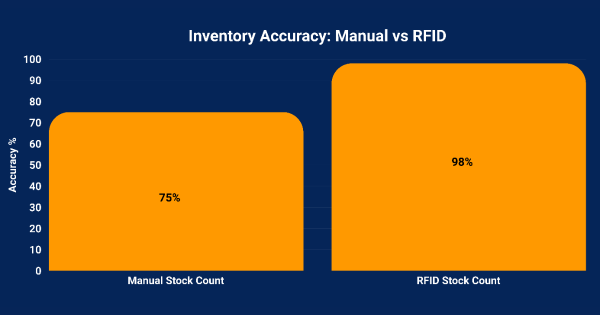The challenge of manual stock counts
For many retailers, accurate inventory management is still a daily struggle. Manual stock counts take hours or even days, demand significant staff resources, and often deliver disappointing results in terms of inventory accuracy.
Research by GS1 and Auburn University’s RFID Lab shows that manual counts are often only 65–80% accurate.¹ The consequences are serious: out-of-stock situations that reduce sales, overstocks that tie up capital, and poor warehouse efficiency that eats into margins. As assortments grow and e-commerce accelerates, manual counting simply cannot keep pace.
Why manual counts slow retailers down
Traditional methods, whether paper-based or barcode-driven, were never designed for the complexity of modern retail. They are slow, labour-intensive and prone to error. Even with barcode scanners, staff spend hours walking aisles, scanning items one by one. Because the process is so time-consuming, many retailers only count stock once or twice a year. That means their data is out of date almost as soon as it is captured. The result is unreliable inventory tracking, poor replenishment decisions and dissatisfied customers.
RFID Stock Count: faster, more accurate, more efficient
RFID technology changes the way retailers manage stock. By attaching RFID tags to items, hundreds of products can be scanned automatically within seconds, without line of sight. A handheld RFID reader covers an entire rack in one pass, feeding data directly into the warehouse management system.
The impact on inventory accuracy is dramatic. Studies and real-world projects consistently show that retailers move from around 70–75% accuracy with manual or barcode counts to 95–99% with RFID.² ³ Because the process is so fast, stock counts can be performed weekly or even daily, ensuring real-time inventory visibility across stores and warehouses.
The benefits for retailers
Retailers adopting RFID Stock Count typically see:
- Shorter stock count times – minutes instead of hours.
- Inventory accuracy consistently above 95%.
- Reduced labour costs and more efficient use of staff.
- Better planning and replenishment, leading to fewer out-of-stocks and overstocks.
- Improved customer experience through reliable on-shelf availability.
Case studies from Inditex (Zara), Marks & Spencer and Macy’s confirm these results, with accuracy levels improving from ~75% to over 98% after RFID adoption.³

Inventory Accuracy Manual vs.Rfid

